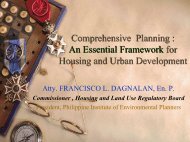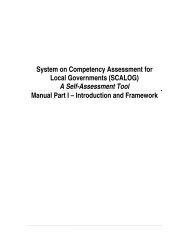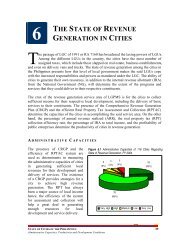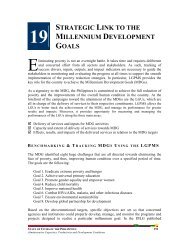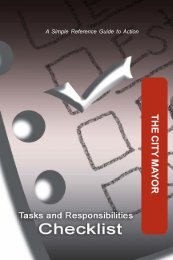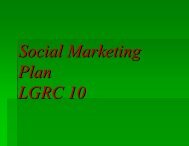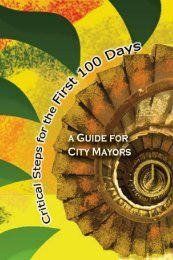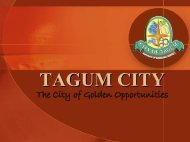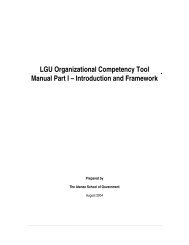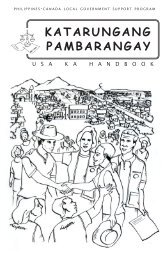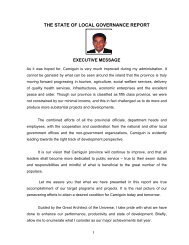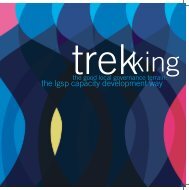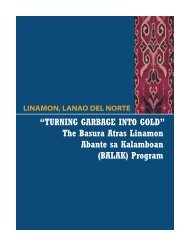Sigma 2005 - LGRC DILG 10
Sigma 2005 - LGRC DILG 10
Sigma 2005 - LGRC DILG 10
Create successful ePaper yourself
Turn your PDF publications into a flip-book with our unique Google optimized e-Paper software.
Kasama Ka!: Multistakeholder Partnerships for Solid Waste Management<br />
SIGMA, CAPIZ<br />
to segregate biodegradables and recyclables. Biodegradables<br />
were recycled through composting at the household level,<br />
while recyclable materials were either sold or turned into<br />
handicraft and other items for sale. Color-coded containers<br />
were placed in schools, markets, offices, and churches<br />
facilitate collection and transfer.<br />
• Collection of segregated waste that is not recycled at the<br />
household level. Wastes that cannot be recycled or<br />
composted at the household level are then collected by the<br />
municipal government. In <strong>Sigma</strong>, daily collection of segregated<br />
wastes is accomplished following a schedule (i.e., Mondays for<br />
papers and cartons; Tuesdays for plastics/Styrofoam, etc.).<br />
Trained volunteer eco-aides with pushcarts and/or eco-carts<br />
go around the barangays collecting the wastes and bringing<br />
these to the Materials Recovery Centers. Four units of ecocarts<br />
and another 4 units of push carts were acquired to do the<br />
collecting.<br />
• Establishing Materials Recovery Facilities (MRFs) and other<br />
facilities as repositories or processing sites for the collected<br />
segregated waste.<br />
The location and land area of these MRFs should be<br />
appropriate and adequate for the purpose; selection of sites<br />
should be determined by the waste survey and other<br />
considerations like accessibility, proximity to households,<br />
environmental safety, etc.<br />
Biodegradable wastes are transported to the Materials<br />
Recovery Facility I (MRF I) for shredding and resizing (MRF 1<br />
houses a shredder), while non-biodegradable wastes are to be<br />
brought directly to MRF II. MRF I is located at the abandoned<br />
40 sqm slaughterhouse. MRF II is located inside the public<br />
market and serves as the final storage and disposal site for<br />
segregated wastes; it includes a tree park, fruit/vegetable and<br />
herbal gardens, surplus center, organic soil production area,<br />
and a showcase for recycled products.<br />
Special wastes from health facilities are screened following<br />
appropriate handling practices at the MRF II, and sent to an<br />
appropriate hazardous waste treatment and disposal facility.<br />
7.5 Ensuring enactment and enforcement of supporting SWM ordinances<br />
and policies (3rd E-Enforcement)<br />
October <strong>2005</strong> 11



